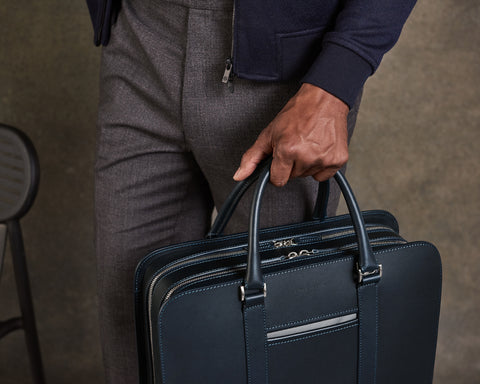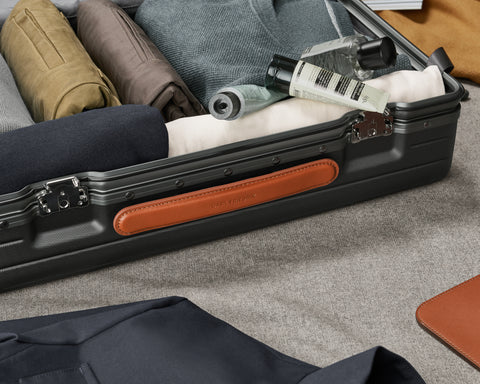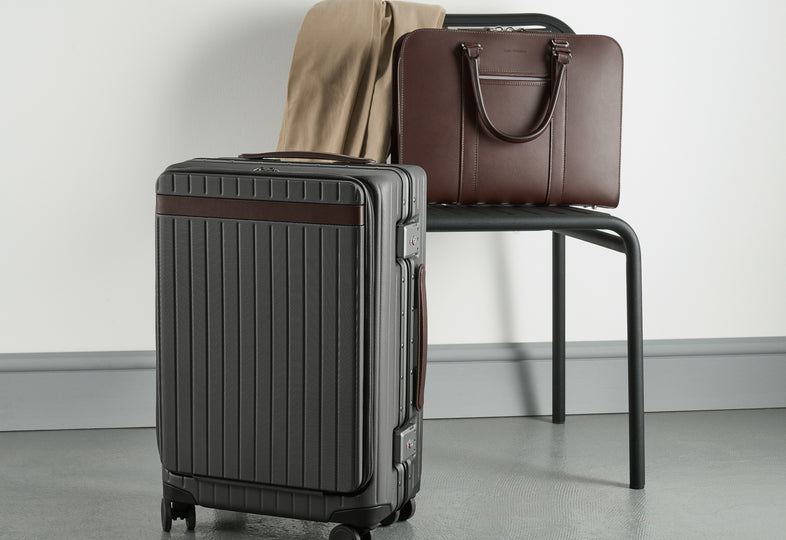Headed on a short business trip and contemplating which piece of luggage would best suit your needs? Or just searching for more information on the briefcase vs suitcase debate?
Either way, you’ve landed in the right place. Because we’re taking an in-depth look at two of the most essential travel cases at your disposal: the suitcase and briefcase.
We’ll touch on the key features of each receptacle, their pros and cons and also their illustrious histories.

What is the difference between a briefcase and suitcase?
The briefcase, first adopted by legal professionals to carry briefs (hence the name), is a bag generally used for transporting business essentials like paperwork, laptops and other gear in daily office life. Although modern briefcases, with their blend of style and functionality, can also make excellent everyday bags.
On the other hand, the suitcase, named for its original purpose of carrying suits for business travellers, is a travel case for safely transporting personal items such as clothing, shoes and toiletries. The suitcase is far more universal and used for all kinds of extended travel, including casual weekend getaways, family holidays and business trips.
It’s worth noting that some modern briefcases, such as our Palissy 25-hour bag, now have the capacity to hold overnight clothing as well as work essentials, which somewhat blurs the line between the briefcase and suitcase. These dual-purpose briefcases are suitably elegant for the office but also great options for short visits or last-minute travel.

Key features of the briefcase
Rectangular and narrow in shape, the briefcase was historically a coveted accessory wardrobe accessory in the corporate universe, that has spilt over to the mainstream in recent decades.
The traditional briefcase was hard-sided with a box-like appearance supported by an internal metal frame. However, modern iterations of the briefcase are generally soft-shelled. They tend to be closed using a metal buckle or zippered mechanism, unlike traditional models that relied on clasps. Expect most modern briefcases to have shoulder straps for your carrying convenience as well.
Typically, briefcases are structured with one main interior space, with additional features like dividers, internal and external pockets and padded sections for laptops. Materials include vinyl, fabric, canvas, aluminium but most typically leather. While leather, vinyl or fabric briefcases may have external pockets or sleeves in addition to the main storage space, the hard-sided metal varieties generally do not have any exterior compartments.

Types of briefcases
Leather briefcase
Durable, flexible, and stylish, the leather briefcase holds much more than paperwork and laptops; it embodies professional prestige and timeless style. A high-quality leather briefcase will grow in character as time passes, developing a rich patina. This level of finesse and endurance makes it one of the most iconic business fashion accessories of all time.
Hard-sided metal briefcase
The hard-sided metal briefcase is exceptionally long-lasting. Typically made from aluminium or even carbon fibre, they are highly resistant to corrosion and general wear and tear. The downside to hard-side is that they’re usually heavier than leather or canvas alternatives, not to mention that the aesthetic pales in comparison with high-end leather briefcases, especially in the boardroom.
Synthetic polymer briefcase
The other commonly used briefcase materials are nylon and polyester. Though not as prestigious as leather, these alternatives still have a variety of benefits. Light, durable and airy, non-leather briefcases are typically more budget-friendly and favoured by creative professionals.

Key features of the suitcase
Suitcases are usually flat and rectangular in shape with a handle at the top. Though the etymology derives from the original purpose of the suitcase (storing suits during travel), contemporary versions offer much more versatility.
The basic structure consists of a shell (soft or hard), reinforced by a metal or plastic frame. While rudimentary forms of the suitcase offered few thrills when it came to additional features, luggage brands are now experimenting with integrated charging ports, built-in hanger systems, TSA-approved locks, automation, weight sensors and much more. Smart luggage really is the future.
Common suitcase materials for hard-sided cases include polycarbonate, ABS and aluminium. For soft-shell cases, ballistic nylon, Cordura nylon and polyester are common. The ultimate objective for manufacturers is to produce suitcases that are both light and extremely hard-wearing, so materials with these properties are invariably favoured.

Benefits of the briefcase
Ideal for office use
Briefcases are generally lightweight, compact and fitted with a range of pockets and padded compartments for holding office paraphernalia, like documents, laptops, chargers and pens. They can be held or positioned over your shoulder for better weight distribution, which makes commuting in with a briefcase very convenient.
Versatility
The briefcase comes in many sizes, colours and configurations, making it a versatile and functional accessory. The size and features you require will depend on your everyday carry and how you plan on using your briefcase. Larger briefcases certainly have adequate room for a spare change of clothing, such as gym apparel.
Durability
An everyday bag needs to be able to withstand the pressures of modern travel and protect expensive electronic devices. Thankfully, many contemporary briefcases are produced from resilient materials, such as leather and robust fabric canvas. Premium leather briefcases wear particularly well, with scuffs and scratches only adding to the bag’s character.
Status symbol
Closely associated with corporate culture and stylish businesswear, the briefcase is an emblem of prestige and professionalism that has inspired confidence in users for decades. If you want to project an image of self-assurance, the briefcase is the perfect receptacle.
At one point, the briefcase had lost its appeal among younger professionals, but the traditional briefcase has now been firmly reinvented. Softer leather and fabrics have mellowed the atypically rigid and corporate appearance of the briefcase, broadening its reach once again.
Disadvantages of the briefcase
- Offer less space than suitcase
- High-quality briefcases are expensive, although long-lasting
- Reputation for being quite traditional and formal

Benefits of the suitcase
Hardwearing
High-quality suitcases are made to withstand the tossing and tumbling that takes place during travel, making them safe for even the most carefree baggage handlers. If you invest in a quality piece of luggage, expect your valuables to be well shielded.
Capacity
Suitcases are ideal for extended travel because they have a far larger capacity than the briefcase. If you’re heading on a week-long capacity, then a briefcase just isn’t going to suffice, no matter how many travel packing articles you’ve read. Certain modern suitcases are even fitted with integrated compression straps and pads or make use of expandable technology so you can pack even more in.
Functionality
Granted, suitcases are bulkier and heavier than a compact briefcase. But technological innovation is making the suitcase an increasingly practical option for many forms of travel. For example, Carl Friedrik’s luggage collection embraces lightweight polycarbonate frames and 360° spinner wheels for maximum mobility.
Statement piece
There’s certainly an argument that the suitcase has transcended its original, purely utilitarian function. Designer luggage brands are producing elegant, streamlined travel cases that are in tune with the trend of luxury travel.
Disadvantages of the suitcase
- Heavier than a briefcase
- Not suitable for everyday use
- More difficult to manoeuvre
Table comparing briefcase vs suitcase
|
Briefcase |
Suitcase |
| Materials |
Leather (animal and vegan), synthetic polymers and metal |
Polyester fabrics or plastics with steel frames |
| Weight |
Lighter and easy to carry |
Often heavier due to size & materials, but include wheels and handles to improve mobility |
| Durability |
Quality briefcases are long-lasting, sturdy and durable |
Generally hardwearing, however, less expensive models can break easily |
| Price |
Price varies depending on the material, brand and features; can be expensive |
Prices range from affordable to expensive, depending on the quality, material and brand |
| Aesthetic |
Timeless, classic design that is ultimately tied with business success |
Often modern, sleek, and stylish designs that contrast with the traditional briefcase |
Carl Friedrik briefcases and luggage
If you're after a briefcase worthy of a high-flying executive or a suitcase that balances style with substance, we have you covered.
Each one of our minimalist-inspired briefcases is handcrafted from Italian Vachetta leather, a material characterised by its rich, earthy tones and butter-smooth texture. They are purpose-built for the modern professional, with features like dedicated laptop compartments and interior pockets to organise your everyday carry.
Our refined suitcases cater to the travel-prone lifestyle of digital nomads and business travellers. From optional USB chargers to ultra-durable aluminium frames and TSA-approved combination locks, each travel case is fully equipped to support you on the road.

History of the briefcase vs suitcase
Briefcase
The inception of the briefcase really begins in the early 1800s when Godillot of Paris began carrying a hinged iron-frame carpetbag everywhere he went. Similar in style to the modern briefcase, the Gladstone bag, created soon after, was a rigid suitcase that could be separated into two sections or compartments.
Briefcases found a foothold in 19th-century British bureaucracy when the infamous Red Briefcase began to be used to hold the royal budget papers on Budget Day in 1860; this tradition lasted until 2010.
In the late 1950’s the narrow, rectangular case that we now know as a briefcase was adopted by those in the legal profession to transport briefs to and from the courtroom.
The briefcase eventually caught on with business professionals in all fields, elevating it to ‘must-have’ status for the style-savvy executive.
In the early 21st century, young professionals started turning away from the stereotypically conservative briefcase, and so it took a brief break from iconic stature. Today, the classic leather briefcase reigns supreme once more, as designers and consumers, armed with the knowledge that some things only get better with time, have brought it back into the spotlight.

Suitcase
The word ‘luggage’, an exact synonym of ‘suitcase’, first appeared in the Oxford English Dictionary as a derivation of lug, literally meaning ‘that which needs to be lugged about’ in 1596.
There is an alluring appeal to the vintage suitcase and the history behind it. The original suitcase was designed for upper-class travellers setting out on lengthy transcontinental trips. These pinewood trunks, as depicted in the movie Titanic, were made with heavy iron bases and rounded tops to survive the harsh conditions.
The golden age of luggage arrived in the latter part of the 19th century when travel became increasingly fashionable for the wealthy and powerful. One of the most prominent designers to the upper-class traveller of the late 1800’s was Louis Vuitton, a young Parisian trunk-maker. He is credited with creating the first flat-top stackable trunk that would become ubiquitous with the growth of train travel.
Luggage became an important consumer product in the 20th century as travel became more accessible to the masses. In the early part of the century, business travellers purchased ‘dress-suit cases’ to store their business attire, and the name suitcase was born.
Evolving to fit the trends and needs of generations, the suitcase has undergone many transformations but has remained an indispensable companion to travellers of all ages, socioeconomic levels and professions.

Takeaway
If you’re a modern professional looking for a practical yet stylish bag for office or everyday use, look no further than a leather briefcase. When it comes to business or leisure travel, however, you can always hang your hat on the spacious and versatile suitcase.
As mentioned before, hybrid alternatives are now cropping up that borrows the best from both the suitcase and briefcase. Carl Friedrik’s Palissy 25-hour briefcase weds the elegance and compartmentalised organisation of the briefcase with the additional room provided by a small carry-on suitcase. Today’s business bags have travelled a long distance, arriving in a world where there’s no such thing as business as usual.









